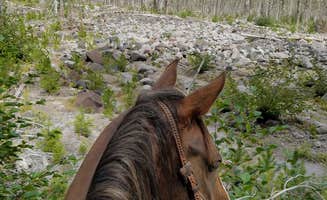Equestrian camping near Underwood, Washington offers access to trail networks throughout the Mount Hood National Forest and Gifford Pinchot National Forest. Most horse-friendly sites sit at elevations between 2,000-3,000 feet, with seasonal weather patterns creating optimal riding conditions during late spring and early fall. Water availability varies significantly across campgrounds, with many requiring campers to bring their own water supply for both people and animals.
What to do
Trail riding on Pacific Crest Trail: Access the PCT directly from Panther Creek Campground where you can connect to miles of forest riding. "The PCT is just outside the campground. Water, pit toilets(clean) and firewood are available. Good spacing between sites, but not a ton of privacy. Saw lots of birds," notes Jeff K.
Fishing in nearby waters: The Columbia River Gorge provides multiple fishing spots within 30 minutes of most campgrounds. At Battle Ground Lake State Park Campground, Brian B. confirms it offers "Great fishing! Trout, bass, blue gill...swimming area. Store on sites. Nice hike around lake with plenty of spots to rest and fish."
Mushroom foraging in fall: The diverse forest ecosystems create ideal conditions for mushroom hunting after seasonal rains. "So close to Panther Creek for swimming on a hot day, taking off to the PCT for a hike, or foraging for mushrooms in the fall," shares Candace from Panther Creek Campground.
What campers like
Natural water features: Many campgrounds provide creek or river access that create natural white noise for sleeping. At Bonney Crossing, Lawrence F. notes "The stones in the stream are a rainbow of metamorphic rock." Another camper adds, "Hear and see the water from half the sites."
Spacious, well-separated sites: Unlike more developed campgrounds, horse-friendly sites typically offer more distance between campers. Ashley B. describes Riley Horse Campground: "The spot I had (Spot 4) was huge, plenty of room for a larger party, felt like a quarter of an acre. There were no neighbors on one side of the spot and only the water spigot on the other."
Variety of terrain types: The transition zone between wet western and drier eastern climates creates diverse riding environments. "An open, relatively unused campground next to a sleep-calling stream right in between the last forested part of Mt. Hood National Forest and the dryer, sage-bushy eastern side of Oregon," explains Bjorn S. about Bonney Crossing Campground.
What you should know
Limited or no cell service: Most equestrian campgrounds have minimal connectivity. At Oxbow Regional Park, a recent camper notes, "Barely got 1 bar of 4g at the welcome center. There's a guest wifi in the parking lot there too but it's 2 miles further to the camp ground and texts hardly go through."
Insect activity varies by season: Early summer can bring heavy insect pressure in some locations. At Clackamas Lake Campground, Colby M. warns, "Seriously, bring bug spray and put it on the minute you get there."
Road conditions require caution: Access roads to horse camps often have rough sections. Amelia L. describes the approach to Cultus Creek Campground: "The drive from Carson to the campsite had quite a few large potholes, but once you get to the site, it's fantastic."
Tips for camping with families
Pack for temperature fluctuations: Due to elevation, overnight temperatures can drop significantly even in summer. At Oxbow Regional Park, J.W. advises, "Road noise can be loud here. Try to get a site as close to the river as you can so you can avoid the highway noise at night."
Look for combined recreation options: Some campgrounds offer both riding trails and water activities. "Nice campground with sites that aren't too close together. It's near Clackamas Lake which is more like marshland than a lake. The good news is that it's only a mile or so from beautiful Timothy Lake," explains Thomas B.
Prepare for primitive conditions: Many horse camps have basic amenities only. "This is a great option as each site is different and pretty spacious. Too bad they're right off the road and the relative lack of trees takes away some privacy," notes Bjorn S. about Knebal Springs.
Tips from RVers
Size limits apply at most sites: Horse-focused campgrounds often have limited turning radius for larger rigs. Marcia O. explains about Tillicum Campground: "We've stayed there in a 11 1/2' pickup camper, and now a 33' class A motorhome, and have had to trim a few limbs in order to get to campsite #12. The interior dirt road erodes more every year."
Consider alternative sites during peak season: When equestrian campgrounds fill up, nearby options may be available. "We stayed here after we couldn't find any open spots at the Timothy Lake campgrounds. It was a nice and quiet spot. Good access to Clackamas Lake," notes Alan L.
Plan for uneven parking: Some horse campgrounds feature split-level designs. At Beacon Rock State Park Campground, Corinna B. describes: "Some sites are split-level, in that you park up top and walk a few steps down to your camp site."


